Related Research Articles

William IV was King of the United Kingdom of Great Britain and Ireland and King of Hanover from 26 June 1830 until his death in 1837. The third son of George III, William succeeded his elder brother George IV, becoming the last king and penultimate monarch of Britain's House of Hanover.

Khafre was an ancient Egyptian pharaoh of the Fourth Dynasty during the Old Kingdom. He was the son of Khufu and the successor of Djedefre.
Teti, less commonly known as Othoes, sometimes also Tata, Atat, or Athath in outdated sources, was the first king of the Sixth Dynasty of Egypt. He was buried at Saqqara. The exact length of his reign has been destroyed on the Turin King List but is believed to have been about 12 years.
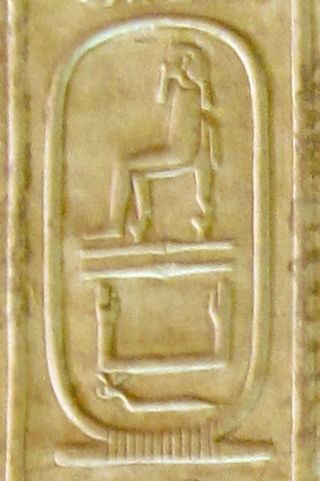
Shepseskaf was a pharaoh of ancient Egypt, the sixth and probably last ruler of the fourth dynasty during the Old Kingdom period. He reigned most probably for four but possibly up to seven years in the late 26th to mid-25th century BC.
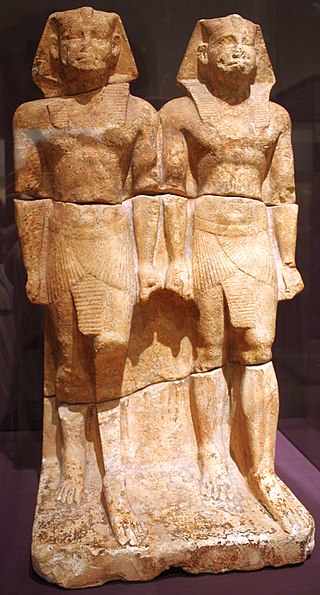
Nyuserre Ini was an Ancient Egyptian pharaoh, the sixth ruler of the Fifth Dynasty during the Old Kingdom period. He is credited with a reign of 24 to 35 years depending on the scholar, and likely lived in the second half of the 25th century BCE. Nyuserre was the younger son of Neferirkare Kakai and queen Khentkaus II, and the brother of the short-lived king Neferefre. He may have succeeded his brother directly, as indicated by much later historical sources. Alternatively, Shepseskare may have reigned between the two as advocated by Miroslav Verner, albeit only for a few weeks or months at the most. The relation of Shepseskare with Neferefre and Nyuserre remains highly uncertain. Nyuserre was in turn succeeded by Menkauhor Kaiu, who could have been his nephew and a son of Neferefre.
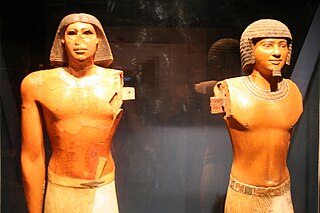
Ptahhotep, sometimes known as Ptahhotep I or Ptahhotpe, was an ancient Egyptian vizier during the late 25th century BC and early 24th century BC Fifth Dynasty of Egypt.
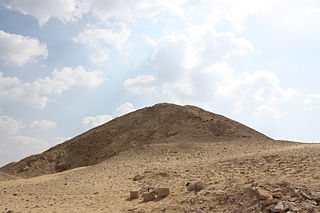
The pyramid of Teti is a smooth-sided pyramid situated in the pyramid field at Saqqara in Egypt. It is the second known pyramid containing pyramid texts. Excavations have revealed a satellite pyramid, two pyramids of queens accompanied by cult structures, and a funerary temple. The pyramid was opened by Gaston Maspero in 1882 and the complex explored during several campaigns ranging from 1907 to 1965. It was originally called Teti's Places Are Enduring. The preservation above ground is very poor, and it now resembles a small hill. Below ground the chambers and corridors are very well preserved.
Peseshet, who lived under the Fourth Dynasty of ancient Egypt, is often credited with being the earliest known female physician in history. Some have credited Merit-Ptah with being the first female physician, but she is likely a fictional creation based upon Peseshet. Peseshet’s relevant title was "lady overseer of the female physicians," but whether she was a physician herself is uncertain. She also had the titles king's acquaintance, and overseer of funerary-priests of the king's mother.

Queen Meresankh III was the daughter of Hetepheres II and Prince Kawab and a granddaughter of the Egyptian pharaoh Khufu. She was the wife of King Khafre.

Kawab is the name of an ancient Egyptian prince of the 4th Dynasty. He was the eldest son of King Khufu and Queen Meritites I. Kawab served as vizier and was buried in the double mastaba G 7110–7120 in the east field which is part of the Giza Necropolis.
Thamphthis is the hellenized name of an ancient Egyptian ruler (pharaoh) of the 4th Dynasty in the Old Kingdom, who may have ruled around 2500 BC under the name Djedefptah for between two and nine years. His original Egyptian name is lost, but it may have been Djedefptah or Ptahdjedef according to William C. Hayes. Thamphthis is one of the shadowy rulers of the Old Kingdom, since he is completely unattested in contemporary sources. For this reason, his historical figure is discussed intensely by historians and Egyptologists.
Jean-Pierre Adam is a French architect and archaeologist specialising in ancient architecture.
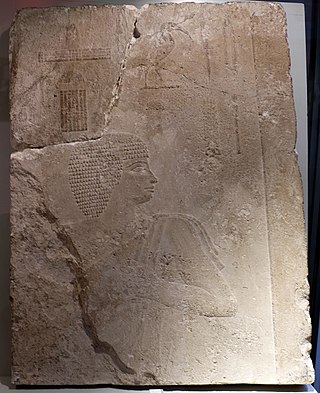
Meritites II or Meritites A was a 4th Dynasty princess of ancient Egypt, probably a daughter of King Khufu. She may have been a daughter of Meritites I based on the fact that this queen is mentioned in mastaba G 7650. She married the Director of the Palace, Akhethotep, and she had several children with her husband. Meritites and her husband shared a mastaba G 7650 in Giza.
Khufukhaf II was an ancient Egyptian high official during the Old Kingdom period. Likely born during the 4th Dynasty, Khufukhaf died during the reign of pharaoh Nyuserre Ini of the mid 5th Dynasty. In modern Egyptology, he is also called Khufukhaf B or Khufukhaf the Younger to distinguish him from his probable father or grandfather Khufukhaf I.

The Tomb of Akhethetep, also known as Mastaba of Akhethetep, is a tomb complex in Saqqarah, Egypt. It was built for Akhethetep, a royal official, near the western part of the Pyramid of Djoser. Akhethetep was an official with several, mainly religious titles. including priest of Heka, priest of Khnum and priest of Horus. The tomb's decorated chapel was removed in 1903 and reassembled at the Louvre in Paris, where it is also known as the "Mastaba of Akhethetep" or simply "le mastaba du Louvre".
Christiane Ziegler, is a French Egyptologist, curator, director emeritus of the Department of Egyptian Antiquities of the Louvre Museum and editorial director of the archaeological mission from the Louvre Museum at Saqqara, Egypt.
Ptahhotep Tjefi, also called Ptahhotep II was an ancient Egyptian official who lived at the end of the Fifth Dynasty, most likely under king Djedkare Isesi and under king Unas. His main function at the royal court was that of the vizier, making him to the most important man at the court, only second to the king. Ptahhotep, whose second name was Tjefi, came from an influential family. His father was the vizier Akhethetep. His grandfather was the vizier Ptahhotep (I). Ptahhotep is mainly known from his mastaba at Saqqara. The burial complex was built for him and his father Akhethetep.
Akhethetep Hemi was an ancient Egyptian official at the end of the Fifth Dynasty, most likely in office under king Unas. His highest title was that of a vizier, making him to the most important official at the royal court, only second to the king. Next to the vizier's titles he was also overseer of the treasuries, overseer of the scribes of the king's document and overseer of the double granary, all these are important position at the royal court.
Akhethetep was an ancient Egyptian official of the Old Kingdom, who is known from his burial at Giza, excavated in 1929–30 by the Egyptian Egyptologist Selim Hassan. Akhethetep had several rather modest titles, including ka-priest of the king's mother, scribe of the treasury or inspector of the scribes of the granary. He was also inspector of scribes at Akhet-Khufu. Akhet-Khufu is the pyramid of king Khufu. His wife was a woman called Nikauhathor. In his tomb are also mentioned on a false door a certain Kainefer and a woman called Peseshet. The latter, with the title overseer of the physicians, is perhaps the first female doctor known by name. The relationship of these two people to Akhethetep is unknown. Selim Hassan wonders whether they were his parents.
Akhethetep was an ancient Egyptian official mainly known from his mastaba found at Saqqara. Not much is known about Akhethetep. On the reliefs of his mastaba he bears several titles, including overseer of the great house. This was an administrative title of rather unclear function. He had also several religious titles, including priest of Maat and priest of Hathor, lady of Dendera. He had also priestly functions at the funerary cult of different kings and was Priest of Nefer-Djedkare (this is the name of the pyramid of king Djedkare and priest at Nefersut-Unas.